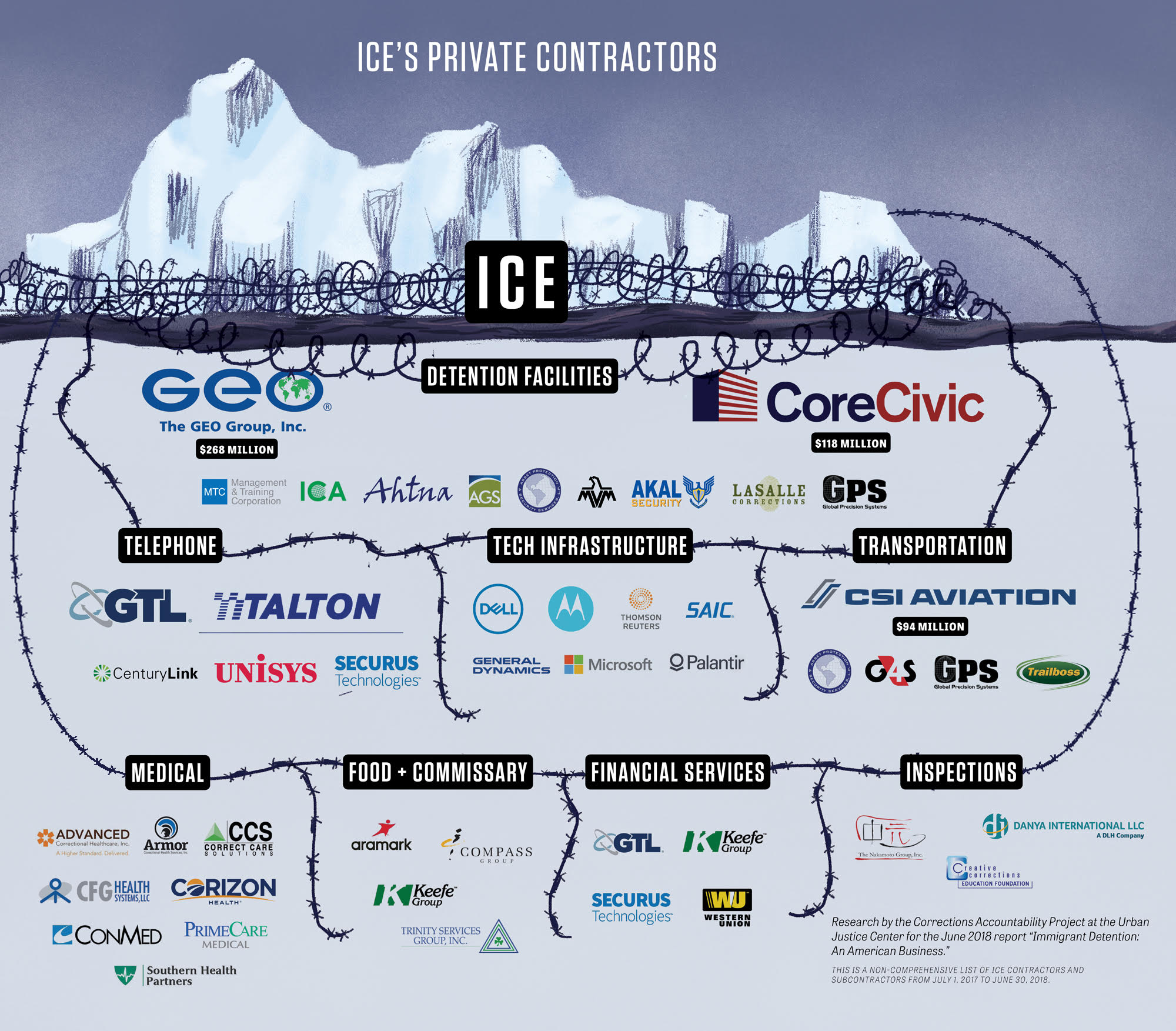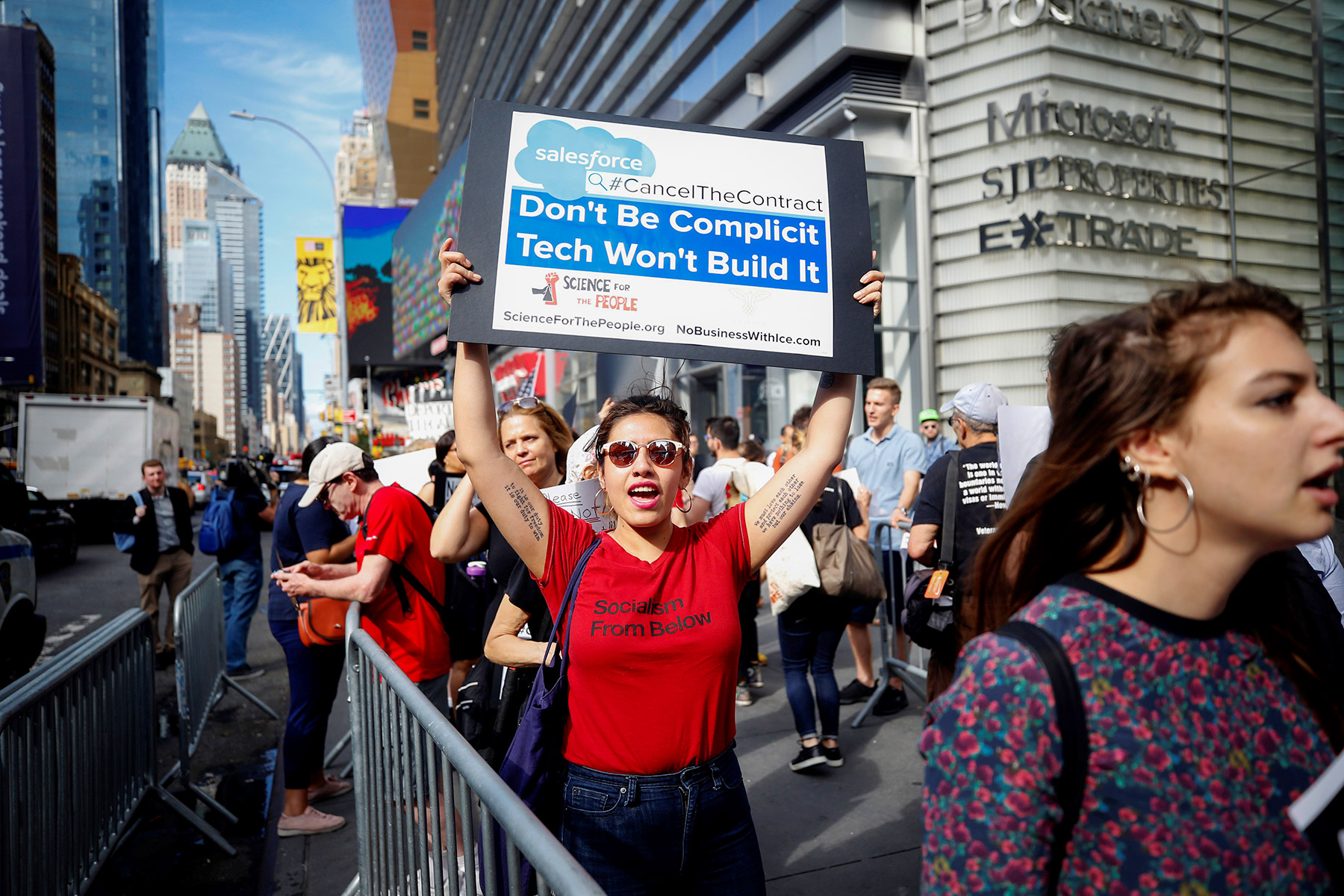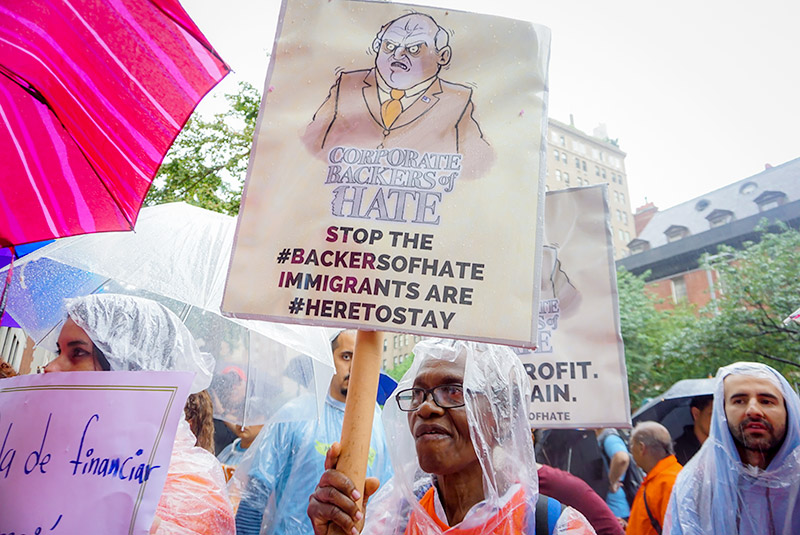Below the Surface of ICE: The Corporations Profiting From Immigrant Detention
Activists are targeting the companies that make ICE run.


Below the Surface of ICE: The Corporations Profiting From Immigrant Detention
Activists are targeting the companies that make ICE run.
September 17 | October Issue
About 60 members of ICE Out of LA faced off with a handful of Trump supporters outside Los Angeles Police Department headquarters July 23. The Immigration and Customs Enforcement (ICE) abolitionist group was there to confront County Sheriff Jim McDonnell, accused of transferring immigrants into federal custody. The Trump fans were there to troll.
“We tell McDonnell to stop siding with people who promote hate in our community,” one young Latino protester shouted through a bullhorn. “He can abolish ICE here.” It was everything you’d expect from a political demonstration focused squarely, if optimistically, on changing the mind of a single policymaker.
Two days later, 2,400 miles away, activists with Make the Road New York and other groups tried a different approach. They blocked Park Avenue underneath the Upper East Side roof-level penthouse of JPMorgan Chase CEO Jamie Dimon, rather than outside a government building. Their speakers blared the now-infamous cries of detained migrant children for their parents.
JPMorgan Chase holds no direct contract with ICE and doesn’t handle financial services at ICE facilities, but it does enable and profit from the private-prison duopoly of Geo Group and CoreCivic, which operate most U.S. migrant detention centers. Since Donald Trump took office, JPMorgan has increased its stockholdings in Geo Group and CoreCivic 15,600 percent. The bank has also provided at least $167.5 million in debt financing to the two companies, which rely on borrowed money.
Going after ICE contractors’ cash flow indicates a new direction in activist organizing since the Trump administration began its controversial family separation policy. ICE relies on private contractors to carry out its detention operations, so one way to abolish ICE might be to make its association so toxic that it loses its collaborators.
Practically every entity that squeezes a dollar from the agency or helps it round up immigrants is being exposed, targeted and swarmed by protesters.

Police handcuff a protester outside JPMorgan Chase CEO Jamie Dimon’s New York City home July 25. Immigrant rights groups are targeting Dimon over JPMorgan’s holdings in Geo Group and CoreCivic, the private-prison companies that operate most ICE detention centers. (Photo courtesy of Make the Road New York)
Traditional immigration activists are now being joined by anti-war, feminist and climate action groups, and others. The broad coordination is possible because the U.S. immigration system bleeds into so many areas of progressive ire, from police brutality and labor abuse to the ongoing wave of privatization and financialization. “We really prioritize building intersectional coalitions,” says Daniel Carrillo, executive director of ENLACE, a racial and economic justice group.
That intersectionality has become critical to left movements, with the shock of Trump’s immigration policies revealing the amoral spectacle of late capitalism. We’ve seen anti-corporate campaigns before in America, but few on this scale, bringing together so many disparate groups— even corporate employees—demanding that companies cease profiting from human misery. The backlash against ICE just might provide a model for a politics and economics that values dignity over the balance sheet.

Several agencies play a role in family separation. Customs and Border Protection handles undocumented border crossings. The Office of Refugee Resettlement shelters unaccompanied minors. But ICE, as the interior deportation force and the largest migrant jailer, has become the avatar for the system’s cruelties.
ICE was established during the golden age of Bush-era privatization in 2003. Though ICE tracks, captures and transports immigrants and imprisons an average daily population of over 41,000 (with plans to increase that to 52,000 in 2019), the part of the agency carrying out that work, Enforcement and Removal Operations, only has 6,000 employees. The vast majority of the immigration machine is left to private-sector contractors.
According to data from the Urban Justice Center’s Corrections Accountability Project, 72 percent of all migrants under ICE’s control sleep in privatized detention beds, mostly managed by private prison behemoths Geo Group and CoreCivic (formerly Corrections Corporation of America). In 2017, Geo Group and CoreCivic together earned $985 million from ICE contracts, more than a third of what ICE spends each year on custody operations. The corporations get paid whether the beds are full or not, arguably providing government an incentive to seek out prisoners so as not to “waste money.”
Geo Group and CoreCivic each run massive family detention centers in south Texas, nicknamed “baby jails” even before the current crisis. They also manage ICEdedicated facilities for adults and many of the federal prisons and local jails ICE sublets to lock up migrants. This practice is likely to expand: ICE posted a request in June for up to 15,000 more family beds at a cost of $1.7 billion annually. And if ICE pivots to electronic monitoring, Geo Group holds that contract, too.
Private prison companies don’t just operate facilities; they build them. As legal entities, both private prison companies claim status as real estate investment trusts. This tax shelter saved Geo Group $43.6 million in 2017 alone, and it boosts revenue as well. Owning and operating detention centers, according to CoreCivic estimates, earns six times more profit per prisoner than just managing operations. Immigrant detention accounted for about a quarter of each company’s revenue in 2017.
After the Justice Department announced the zero tolerance policy in April, thousands of children separated from their parents became “unaccompanied minors” under the control of the Office of Refugee Resettlement, which also contracts out its custody operations. Shuttered Walmarts, hotels, temporary tents and even empty office buildings in Phoenix (where children bathe in sinks) have been converted into migrant child jails. Over a dozen private contractors manage facilities, from nonprofit Southwest Key, which has earned at least $955 million on contracts since 2015, to defense contractor MVM Inc. And when children rotate into foster care, for-profit companies like Cayuga Centers take them on. Sheltering unaccompanied minors is now a $1 billion business, with more contracts on the way.
Migrants must be fed and cared for while detained; none of that work is handled by ICE staff. Instead, kitchen, phone, medical, translation and financial services are contracted mostly to specialists that perform the same tasks in private prisons. ICE even contracts out its inspections; a recent inspector general report found that one private inspector, the Nakamoto Group, had waved through substandard facilities.
Other contractors transport migrants between facilities or deport them to home countries. When commercial airlines balked at transporting minors ripped from their families, defense contractors stepped in, including General Dynamics and MVM, which has earned $123 million since 2014 for transportation services. CSI Aviation has a contract to run “ICE Air” for charter deportation flights.
Far from shelters and shuttles, contractors supply logistical support for immigration agencies. Consulting firm Deloitte earned $18 million in 2017 for case management. Salesforce has a software contract with Customs and Border Protection. Microsoft handles ICE’s data processing. An obscure surveillance firm called Pen-Link provides ICE with “real-time tracking” through cell phone and geolocation data. Another logistics infrastructure contract with Palantir, a Silicon Valley data-mining firm owned by libertarian Trump supporter Peter Thiel, uses Amazon’s cloud computing storage.
ICE spent $1.7 billion on close to 5,000 contractors in 2017, the most money this decade. “The immigration system is used as a vehicle to extract wealth from communities, or at the very least as a vehicle to launder taxpayer money into the private sector,” says Bianca Tylek, director of the Corrections Accountability Project.
The motivation to maximize revenue by cutting corners contributes to a nightmarish experience for detainees. Under private contractors, allegations of inedible food, verbal and physical abuse, inadequate medical attention, children covered in lice, and forced ingestion of psychotropic drugs are commonplace. Many migrants work in the facilities for just $1 a day under virtual slave conditions. Members of Congress have complained that detention phone operators charge parents separated from children up to $8 a minute to speak to them.
More than 1,200 allegations of sexual assault at both public and privately run adult detention facilities were filed between 2010 and 2017, and police reports indicate hundreds more incidents victimizing children. One HIV-positive worker at Southwest Key was charged in August with molesting at least eight minors; other Southwest Key cases involve children as young as 6. “If you’re a predator, it’s a gold mine,” said one psychiatrist. Unconfirmed reports of suicides and deaths in custody cap off the grim scene.
These abuses have become a fact of life in private immigration detention, with billions of dollars paid in legal settlements over the allegations. But as national attention focused on the border, Americans couldn’t escape the shocking reality. “We are seeing the unveiling of how immigration enforcement treats humans like animals,” said Ana Maria Archila, co-executive director of the Center for Popular Democracy.
Immigration agencies have no problem with private contractors absorbing the blame when abuse complaints arise. Outsourcing also shields facilities from Freedom of Information Act (FOIA) requests. While the Supreme Court confirmed in 2017 that the government must release details of its private prison contracts, the subcontractors that provide private prison companies with things like food and medical services don’t have to comply with FOIA requests. “Private prison companies are almost like a general contractor in a construction deal,” says Tylek. “They subcontract out the services, and those subcontracts can’t be FOIA’d because there’s no contract with the government.”
But because of the relentless privatization of the immigration system, activists have new pressure points: contractors who must answer to investors, financiers, workers and, in some cases, millions of consumers.
“If we actually do want to change policy, we need to know who has the power,” says Jeremy Mohler, communication specialist for In the Public Interest, an anti-privatization research group and one of many organizations that have pieced together the network of ICE enablers. “And a lot of the power is invested in these corporations.”


ICE claims its multimillion-dollar research contract with Northeastern University in Boston funds “critical research to help combat terrorist explosive attacks,” but demonstrators were skeptical July 11. An online petition urging the university to end its contract has collected more than 2,000 signatures. (Photo by Jonathan Wiggs/The Boston Globe via Getty images)
In June, progressive groups formed the Families Belong Together coalition to express revulsion at the spectacle of children being ripped from their families. Following the model of the Women’s March and the March for Our Lives against gun violence, Families Belong Together planned mass demonstrations. The breadth of the coalition was exceptional, bringing together environmentalists at 350.org and Clean Water Action, progressive Jews at J Street and Bend the Arc, National Domestic Workers Alliance, the Center for Reproductive Rights, End Rape on Campus, the American Federation of Teachers, Rock the Vote, and hundreds more.
It didn’t take much for groups to justify their involvement. “Two-thirds of the people impacted by immigration policy are women and children; this is very much a woman’s issue,” says Kristin Rowe-Finkbeiner, executive director of MomsRising, one of the coalition leaders. MomsRising was involved in immigration advocacy before the family separation policy sparked mass outrage, but the issue took on new resonance afterward. “None of us want to explain to future great-grandchildren what we did when history went in the wrong direction.”
The June 30 marches, with hundreds of thousands participating in nearly 750 cities across the country, revealed the movement’s popularity. One of the coalition’s first requests after the marches was to cut off funding to the private prison duopoly, not only by severing their ICE contracts but by going after their lenders. “If the banks stop financing [private prison companies], it creates a huge political and logistical challenge for the administration,” says Matt Nelson, executive director of Presente, a leading Families Belong Together partner.
In the Public Interest researched in 2016 how six banks— Bank of America, JPMorgan Chase, BNP Paribas, SunTrust, U.S. Bancorp and Wells Fargo—provide revolving credit, term loans and corporate bond underwriting to CoreCivic and Geo Group. The banks fund the construction of new detention centers, acquisitions of smaller companies and general cashflow. According to an April report published by the Center for Popular Democracy, between 90 and 95 percent of CoreCivic and Geo Group’s cash on hand was borrowed in 2017. Interest payments on that debt equaled $217.5 million. As of March 2018, the two companies carried $3.1 billion in debt. These six banks, in addition to profiting from the private prison duopoly, are vital to its existence. And banks have to face consumers, making them an inviting target for activists.
Families Belong Together singled out JPMorgan Chase and Wells Fargo, whose image has already been battered by a cascading series of scandals, for a petition drive. Numerous organizations joined in, collecting over 100,000 signatures from customers and concerned citizens. “Jamie Dimon put out a statement that his heart goes out to the families,” says Ana Maria Archila, co-executive director of the Center for Popular Democracy. “It is not possible to say you’re standing for an inclusive society while facilitating the growth of an industry caging humans.”
The goal of the protest at Dimon’s apartment was to embarrass him in his Upper East Side neighborhood. Protesters included undocumented immigrants and former detainees at CoreCivic facilities. “We wanted to send Dimon a clear message and have the people that live around him know what’s going on,” says Make the Road New York spokesperson Yatziri Tovar. It came one day after another demonstration in front of the New Jersey home of a Wells Fargo board member. Direct contractors have also faced protests in at least 16 cities. In July, two dozen activists chained themselves in the Centerville, Utah, office of Management & Training Corporation, which runs a handful of ICE jails. The Dream Defenders conducted a national day of action at Geo Group facilities August 7, which shook the company so much it issued a cease and desist accusing the group of “inciting a dangerous ‘disruption.’”
Win Without War, an anti-war group, demanded that military contractors General Dynamics and MVM drop their contracts. Demand Progress, which normally organizes around net neutrality and NSA spying, called on Salesforce to stop working with Customs and Border Protection. “We got involved because we saw the nexus between big, unaccountable tech companies and government oppression, especially surveillance,” says Robert Cruickshank, campaign director of Demand Progress. “These tech companies are making it easier for law enforcement to target and harass people, especially people of color and immigrants.”
The tech industry is now facing an awkward predicament: fending off worker-led organizing. The immigration-focused uprising grew organically from left-leaning Silicon Valley engineers and coders’ stance against collaboration with the Trump administration. They scored a major victory at Google in June when the company cancelled artificial intelligence work for the Defense Department. “Workers were learning how to wield power within their companies,” says Yana Calou, an organizer with Coworker.org, which has been assisting tech employees in these fights.
Weeks after the Google victory, workers circulated open letters at Amazon, Microsoft and Salesforce, asking CEOs to cancel their immigration contracts. Chief executives lamented the plight of migrants and insisted that none of their work involved separating families, which placated nobody. “Tech infrastructure is absolutely integral to all of [ICE’s] operations,” says Calou. “If they were really concerned about reuniting families, they would be building tech for the families.”
To blunt criticism, Salesforce tried to donate $250,000 to RAICES, an immigrant justice group raising money to post bonds for detainees. RAICES rejected the money, responding that “when it comes to supporting oppressive, inhumane, and illegal policies … the only right action is to stop.” Several business users of Salesforce’s software threatened to end their relationship with the firm if the immigration contract remained.
Outside groups amplified worker voices with petitions and rallies. More than 300,000 people signed a letter from the racial justice group Color of Change supporting employee demands at Microsoft and encouraging other tech workers to join.
The organizing has bled over into anti-discrimination rights on the job, more diversity in hiring policies, and an ethical framework for profiting from the tools they create. Organizations like the Tech Workers Coalition and Silicon Valley Rising promote this cross-pollination and pitch in on bargaining work with janitors and cafeteria workers on tech campuses. Calou views it as part of the same awakening.
“This is the first time we’ve seen this happen in tech companies: a group thinking of themselves as workers,” Calou notes. “The more they’re organized as workers, the better they can advocate for themselves and show solidarity.”
ICE claims its multimillion-dollar research contract with Northeastern University in Boston funds “critical research to help combat terrorist explosive attacks,” but demonstrators were skeptical July 11. An online petition urging the university to end its contract has collected more than 2,000 signatures. (Photo by Jonathan Wiggs/The Boston Globe via Getty images)


Salesforce is contracted with U.S. Customs and Border Protection to use its cloud technology for information sharing. Protesters put the company on notice at the #WeWontBeComplicit march in New York City on July 31. (Photo by Atilgan Ozdil/Anadolu Agency/Getty Images)
Movimiento Cosecha (The Harvest Movement), an immigrant justice organization, defines complicity with ICE as being involved in or facilitating deportations. The group targets even more casual connections, like when Customs and Border Protection agents boarded Greyhound buses asking for identification from Latinx passengers or when Motel 6 allegedly gave ICE information on Latinx guests.
“The more institutions stop working with ICE, the more people are forced to ask themselves, which side am I on?” says Arielle Clynes, an organizer with Cosecha.
Cosecha’s No Business with ICE campaign kicked off in early July at an Amazon bookstore in Manhattan’s Columbus Circle. “We wanted to make a statement that if Amazon does business with ICE, we’re not going to let them do business at all,” Clynes says. Cosecha activists blocked the entrance with a rally and shut down the store for the day.
The pressure escalated during a July 31 day of action in 10 cities. In Boston, hundreds marched at Northeastern University, which holds a $7.8 million technological research contract with ICE; twelve were arrested after lying down in the street in front of university President Joseph Aoun’s home. In Philadelphia, eight protesters were arrested after occupying the lobby of the Comcast Center for 90 minutes; Comcast provides internet access to ICE. In New York, Cosecha partnered with Science for the People on a march from Microsoft and Salesforce headquarters to an Amazon Books on 34th Street. In Palo Alto, the group targeted Palantir headquarters.
Other Cosecha protests focused on municipal officials. Local coordination with ICE has spiked in the Trump era, with DMVs, hospitals and even public schools sharing personal data on immigrant families. In liberal cities like Los Angeles and Philadelphia, activists are demanding that public officials live up to their values, but even redder towns like Grand Rapids, Mich., and Williamson County, Texas, have seen protests.
The next wave of the campaign will target investors in the lucrative immigrant detention industry. The American Federation of Teachers (AFT) released a report August 10 identifying 26 hedge funds holding over $4 billion in stock in Geo Group, CoreCivic and General Dynamics. The report urges public pensions serving AFT’s teachers, which carry over $3 trillion in assets under management, to dump those hedge funds from their portfolios. AFT President Randi Weingarten condemned the hedge funds for “abetting the administration’s policies of family separation and the permanent harm it has caused children.”
Beneficiaries of immigration-related investments include the burgeoning class of multi-millionaire politicians. Illinois Gov. Bruce Rauner (R) has money in a private equity fund that owns Correct Care Solutions, a healthcare provider that serves immigrant jails. Montana Rep. Greg Gianforte (R) bought at least $100,000 in CoreCivic stock in January. SuperPACs for Florida Gov. Rick Scott (R), who is now running for U.S. Senate, took hundreds of thousands of dollars from Geo Group.
But the firms spread their cash around to both parties. Democrats in Congress have scrambled to clean up their campaign treasuries. Records show the Democratic Congressional Campaign Committee, the campaign arm for House Democrats, taking a direct $10,000 donation from Geo Group in November 2017, and over $380,000 throughout the 2018 election cycle bundled by lobbyists connected to private prison companies. New York Gov. Andrew Cuomo has been criticized for taking money from landlords who rent out field offices to ICE.
The pressure put on anyone profiting from or enabling ICE complements the direct-action tactics of a growing movement known as Occupy ICE. Abolitionists have physically blocked entrances to ICE buildings in San Francisco, Louisville, and Tacoma, Wash., leading to confrontations with law enforcement. In Portland, Ore., ICE temporarily closed its facility; in Los Angeles, one entrance has been barricaded since late June. An Occupy ICE blockade in Denver drew a SWAT team and ICE employees had to drive across the lawn to leave the building. “As much as we can, we’d like to interrupt their ability to do their job,” says one of the protesters arrested in Denver, who requested anonymity while his case is pending.

Out in the elements, protesters rally at JPMorgan Chase CEO Jamie Dimon’s Park Avenue penthouse July 25. (Photo courtesy of Make the Road New York)
The multi-pronged campaign against ICE and its private-sector partners is having an impact. After media scrutiny, MVM canceled its lease on the Phoenix office building housing migrant children. Consulting firm McKinsey terminated its contract with ICE, although its management consultant work for the agency had already been completed. New York state directed all its pension funds to divest from Geo Group and CoreCivic, following New York City and Philadelphia. At least 10 members of Congress have rejected Geo Group donations, along with state Democratic parties in California and Florida. Many politicians and parties have passed on donations to organizations protecting immigrants at the border.
But the movement is hoping for a signature victory. So far, no household names, like General Dynamics or Microsoft, have severed contracts with immigration authorities, and Amazon recently promised its “unwavering” commitment to work with law enforcement. ICE abolitionists plan to keep up the pressure. “We don’t see activism fatigue; we see people stepping up,” says Kristin Rowe-Finkbeiner of MomsRising.
Perhaps the most progress has been made in getting cities to cancel ICE contracts. Philadelphia Mayor Jim Kenney revoked ICE’s access to a city law enforcement database, a huge win for local organizing groups. Atlanta Mayor Keisha Lance Bottoms prevented city jails from accepting new ICE detainees. And at least six cities and counties have canceled ICE contracts to use detention centers in their areas.
Bob Libal, executive director of Grassroots Leadership, recounts the organization’s victory in suburban Williamson County, Texas. The county voted in June to end its contract in January 2019 for the T. Don Hutto Detention Center, a CoreCivic-run women’s facility long accused of rampant abuse, though ICE could scramble to try and renegotiate. Grassroots Leadership used the testimony of 40 Hutto detainees separated from their families to sway county commissioners. “We had people going to the county every week to read letters of women detained there,” Libal says. “It was really the powerful experience that won.”
Some immigrant rights groups are wary of county closures because of the potential impact on current detainees. When Contra Costa County, Calif., Sheriff David Livingston revoked ICE’s contract to house migrants at the West County Detention Facility, the group Freedom for Immigrants feared detainees would be moved across state lines, far from their families and legal resources. “Canceling the contract shows that these protests are working,” says Liz Martinez, advocacy and communications director for Freedom for Immigrants. But the real goal, she says, is “to get people out of detention.”
Libal, whose Grassroots Leadership has been trying to close down the Hutto detention center since it opened in 2006, says it was critical for the movement to gain momentum. “You have to fight back somewhere, and one way to be effective is to win local battles,” he says.
Geo Group has lost at least one contract because of its association with family separation. Lancaster County, Penn., rejected a Geo Group attempt to take over prison re-entry services, even though the contract had nothing to do with immigration. “If they get painted as the family separator, that’s going to hurt them across the board,” says Jeremy Mohler of In the Public Interest.
Attacking the money alone will not fulfill the end goal; abolishing ICE will require legislation. But in the meantime, making ICE toxic can have powerful effects, preventing a return to the pre-Trump status quo of undocumented immigrants being treated abominably in virtual obscurity. It’s already shown up in polling data; in just a few short months, ICE is net unfavorable, even less popular than the IRS. When a concept bleeds into the culture, as Abolish ICE signs are being seen at sporting events and the Statue of Liberty, that signals the ground is shifting. “Even people who don’t want to abolish ICE really hate ICE,” says Sean McElwee, who popularized the Abolish ICE slogan. “It’s defined in an incredibly negative way, and that makes it hard to do its job.”
Combining street protests with research on who profits from the immigration system—a Gordian knot of opaque subcontracting and financing relationships that activists have been picking at for years—is critical to that effort. When every uniform, every catered meal, every transportation shuttle, everything ICE does is contested, it throws sand into the gears of its operation.
ICE’s extreme privatization was a catalyst to produce these pressure points, but it also speaks to a disconnect between capitalism and morality, and how family separation reveals those fissures. The ICE fight is about human rights but also labor rights—the rights of workers to exert democratic control over company contracts and reject immoral work. It’s about small towns with dried-up economies that have no choice but to become America’s migrant jailers. It’s about the influence of lobbyists, and also financiers. It’s about how the public gets a say in how public money should be spent. It’s about the over-criminalization that gets the undocumented on ICE’s radar. It’s even about our energy policy, with climate refugees soon to follow the current wave of asylum seekers fleeing violence.
“A lot of times in our politics, there’s a singular focus on who is elected and who might hold formal reins of power,” says Kevin Connor, co-founder of Little Sis, which has focused on ties between political and financial elites for years. “This is a moment where people are seeing a power structure above and beyond that. Research systems and organizing can lay the groundwork for this kind of moment where that power structure can be challenged more directly.” 
This story was supported by the Leonard C. Goodman Institute for Investigative Reporting.
Salesforce is contracted with U.S. Customs and Border Protection to use its cloud technology for information sharing. Protesters put the company on notice at the #WeWontBeComplicit march in New York City on July 31. (Photo by Atilgan Ozdil/Anadolu Agency/Getty Images)
is an investigative fellow with In These Times’ Leonard C. Goodman Institute. His book Chain of Title: How Three Ordinary Americans Uncovered Wall Street’s Great Foreclosure Fraud won the 2015 Studs & Ida Terkel Prize.
Get the latest news and investigative coverage. Subscribe to the free In These Times weekly newsletter:
